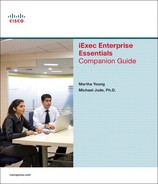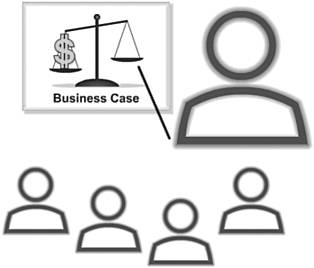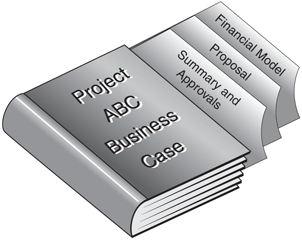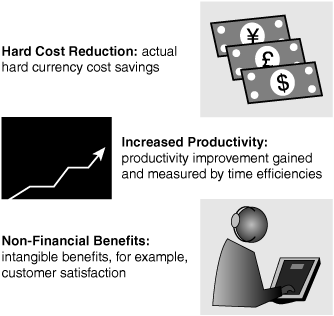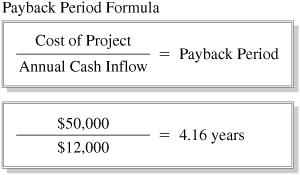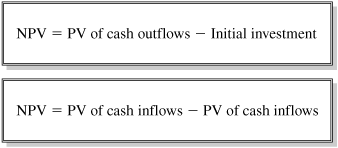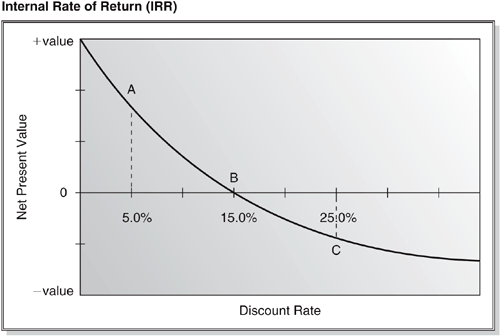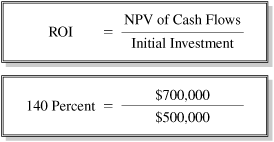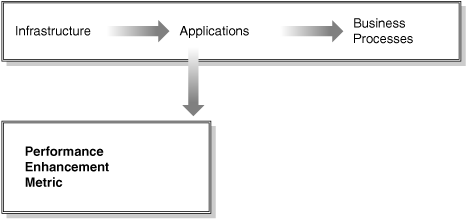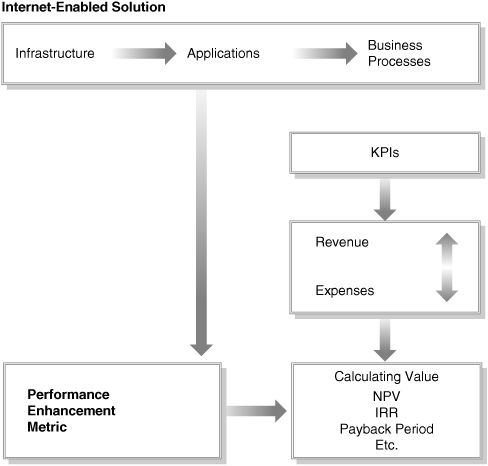Up to this point, you have learned the individual components that make up the planning process. You know what value Internet-enabling the business brings, what a networked virtual organization (NVO) is, how to determine where your company is today, and how to determine where you want to take the firm in the near and long term. You have discovered a variety of tools, methods, and metrics to assess firm readiness from an internal as well as external perspective. This section explores what a business case is, discusses why it is important to create a business case for your information technology (IT) initiatives, and briefly reviews the main components of a business case. Upon completion of this module, you will be able to answer the following questions:
What is a business case, and how is it used to create a project proposal?
When should you create a business case and project proposal?
What are the major components of a business case and a project proposal?
Upon completion of this module, you should be able to do the following:
Recognize when to create a business case.
Identify the major components of the business case.
Compare financial and nonfinancial justifications.
Apply financial calculations to support a business case.
A business case is an important element of business planning. Its purpose is to justify a specific investment of resources and benefits for a new initiative or project inside an existing organization relative to existing projects and other opportunities. You can think of a business case as a way to measure opportunity costs of one initiative over another. Figure 7-1 shows the process for developing a business case. Firms use business cases to weigh the costs and benefits of a project relative to the decision-making process.
A business case does the following:
Provides sound business reasons for implementing the proposed Internet-enabled project or initiative
Illustrates where the IT project fits within the overall organization. For example, it justifies the initiative based on the mission and goals of the organization
Explains the impact that the proposed new technologies will have on the organization
Contains the roadmap and milestones of implementation with more detail than the overall business plan
Defines the success metrics for the initiative
Highlights the risks and benefits to the firm that are associated with the initiative
A business case is developed in the selection and planning phase, after opportunities have been identified and need to be sorted out in terms of value to the firm. It is not unusual to develop business cases for multiple initiatives concurrently, for it is in this phase of deeper analysis that a company can better determine which initiative will drive greater returns on the limited resources more quickly than a competing initiative. Business cases are developed for a variety of reasons. Figure 7-2 shows a group of people who represent different departments within a company. This is one reason to develop a business case. A business case would also be created in these circumstances:
The initiative spans multiple departments or organizations, and the proposed plan needs to be shared or justified to others.
An organizational or business process change is needed.
New or different initiatives need to be justified relative to the overall goals and objectives of the company.
Investment dollars and other assets are being requested for a new initiative.
Business cases come in different depths depending on the size and scope of the proposal. For example, a proposed major shift in a business process, say moving to out-tasking, would require a more detailed and in-depth business case than upgrading employee desktops. You can develop a business case in numerous ways, but most business cases include some common components. The major components of building a business case are shown in Figure 7-3. Think of these components as the building blocks for creating the foundation structure for your proposed project.
The following are the major components of a business case:
Summary and approvals: These provide the decision maker with the basic information from your business case that is required to reach an informed decision.
Proposal: This gives the decision maker detailed information supporting a business case.
Financial model: This supports an investment proposal and rationale for making the investment. The purpose of the model is to try to quantify the financial impact of an investment.
The business case tool provides a framework for communicating key information regarding a proposed case. This is so both business and IT can understand the objectives, significance, costs, return on investment (ROI), impact, and timing.
The business case components should include the actions and resources to achieve the desired results of your IT initiative.
The business case document should include each of the following:
Business issues/problem statement
Project overview and proposed solution
Project justification
Project benefits and risks
Project success measurements and metrics
Financial analysis (cost/risk/return)
Adoption plan
Recommendations
To help you write a business case, use the following template. Consider it a living, breathing document. Initially, you will have only some of the information for each section that pertains to your project.
This section aids in tracking who modified the business case and when the modifications were made.
The revision history for this document is as follows.
Version | Date Revised | Author | Comments/Changes Made |
|---|---|---|---|
Describe the organization’s mission and vision for using the Internet and IT to accomplish the business objectives and goals of the organization.
___________________________________________________ ___________________________________________________ ___________________________________________________ |
Describe the internal and external situation of the organization that is driving the need for change. You might want to add the strengths, weaknesses, opportunities, and threats (SWOT) analysis that led you to your conclusions.
___________________________________________________ ___________________________________________________ ___________________________________________________ |
Describe the business issue(s) or problems that will be addressed in the solution.
___________________________________________________ ___________________________________________________ ___________________________________________________ |
Describe the new capabilities or process change using the Internet and IT to address business issue(s) or problems that will be addressed to achieve the desired benefits.
___________________________________________________ ___________________________________________________ ___________________________________________________ |
Describe the scope of the project, including the human and capital resources of hardware, software, and services, that are needed to deliver the solution.
___________________________________________________ ___________________________________________________ ___________________________________________________ |
Describe the business processes that your project will impact. You might want to include in the appendix process maps or cross-functional flowcharts.
___________________________________________________ ___________________________________________________ ___________________________________________________ |
List all the executive sponsors and their titles, and describe their roles.
Executive Sponsor Name | E-Mail Address | Title | Phone Number |
|---|---|---|---|
List all the key stakeholders—internal and external—and their titles, and describe what portion of the project they are championing.
Key Stakeholder Name | E-Mail Address | Title/Function | Phone Number | Organization |
|---|---|---|---|---|
List all the team member names. Also include the name of the business and technical project leaders.
Team Member Name | E-Mail Address | Title | Phone Number |
|---|---|---|---|
Describe the areas that your project will address, such as reducing costs, increasing productivity, improving customer care, and so on. It is important to include firm, measurable metrics, and key performance indicators (KPI) at this point in the project business plan.
___________________________________________________ ___________________________________________________ ___________________________________________________ |
Describe the high-level benefits, including hard, measurable benefits (increased sales, for example) and soft, immeasurable benefits (such as increased customer loyalty).
___________________________________________________ ___________________________________________________ ___________________________________________________ |
Describe the risks (business process, technology, resource, vendor, or other) that could adversely affect the success of the program or application, and list key assumptions.
___________________________________________________ ___________________________________________________ ___________________________________________________ |
Describe the business costs associated with this project, including any outstanding cost issues that were not initially listed due to limited information or analysis. If cost issues are unknown, describe the process to gather this information.
___________________________________________________ ___________________________________________________ ___________________________________________________ |
This is the preliminary project cost, based on original estimates.
___________________________________________________ ___________________________________________________ ___________________________________________________ |
These are the final costs, including the ongoing management and maintenance of the program.
___________________________________________________ ___________________________________________________ ___________________________________________________ |
Describe what the return on investment (ROI) would be for this project. Depending on the criteria used within your organization, your financial analysis might use ROI, internal rate of return (IRR), net present value (NPV), or payback period.
___________________________________________________ ___________________________________________________ ___________________________________________________ |
Describe in detail the process plan for ongoing support for this program. After the program is implemented, describe how users will get support when they have questions or problems.
___________________________________________________ ___________________________________________________ ___________________________________________________ |
Describe in detail the process plan for change management, including what processes need to be changed and how they will be managed on an ongoing basis.
___________________________________________________ ___________________________________________________ ___________________________________________________ |
Describe the training program that will need to be created to teach the users how to use this program or application. Note: Coordinate internal training groups to make them aware of this project and ensure they will be able to detail everything that will need to be done, including a timeline. Include information on how future new hires will be trained.
___________________________________________________ ___________________________________________________ ___________________________________________________ |
Describe in detail the communication plan you will use to communicate to the users concerning this program and the application. Indicate the method of communication, intervals of communication, and other feedback loop components.
___________________________________________________ ___________________________________________________ ___________________________________________________ |
___________________________ | ___________________________ |
Sponsor Signature | Print Sponsor Name |
___________________________ | ___________________________ |
Project Manager Signature | Print Project Manager Name |
___________________________ | ___________________________ |
Business Owner Signature | Print Business Owner Name |
Place any information or diagrams that will not fit in the previous sections, and then reference them to the section they refer to.
Financial measures apply to all aspects of the company. Various financial measures are used as a way to determine how the company is doing overall. Other financial metrics are available, however, to estimate the potential return on individual projects and initiatives and measure the actual success after a project has been implemented. As you develop your business case and project proposals, you need to show the financial impact of the IT investments both before and after implementation. This section covers key financial concepts to help you evaluate the financial impact of your investments.
You will explore the following:
Financial and nonfinancial justification
The four common financial calculations used for investment impact:
Payback period
NPV
IRR
ROI
Metrics and KPIs
Although financial analysis is important to most business cases and IT projects, you should also take nonfinancial considerations into account when preparing a business case for change. Nonfinancial considerations, or qualitative analysis, are soft measures that firms need to include in their evaluation of business cases. Typical soft metrics address the question: How will this initiative improve a specific process or the business overall? Common soft metrics include these:
Improved customer service
Improved access to information
Improved satisfaction
Learning gained through the project
Recall from Module 2, “Management Strategies,” that a business seeks to maximize revenue and reduce costs. Module 2 was looking at an organization from a macro point of view. Business cases and project assessment seek the same value proposition—maximize revenue and reduce costs—but the view is a micro level. Projects typically have three types of benefits, as shown in Figure 7-4.
An Internet-enabled business provides benefits that are unique to the NVO business model. Specific examples of each of the three benefits are noted next.
Savings on office space reduce real estate costs
Printing costs are virtually eliminated when documents such as directory and internal communication are transmitted electronically
Travel and hotel costs are reduced for offsite trainings when conducted via collaboration technologies such as audio conferencing
The reduction in real estate needs results in a concurrent reduction in facilities management costs
Cheaper, faster procurement is enabled by online procurement
Postage and shipping costs are reduced or eliminated in the NVO
Staff can be redeployed to more value-producing activities and away from sunk command/control activities such as these:
Travel/vacation/permit requests and authorizations
Expense report management
Employee timesaving is gained from not having to submit the following:
Travel/vacation/permit requests and authorizations
Expense report submission
Employee timesaving is also gained from being able to utilize the following:
Employee directory use
Senior management mobility
Web communication solutions
Having a digital signature solution is another employee and customer timesavings.
Community leadership
Reputation as a forward-looking organization
Openness to innovation, including building future capability and capacity
Project image of modernity to stakeholders, such as organization as innovator
Citizen service accessibility for better responsiveness
Quality of service (QoS), including reduced cost and faster services that meet citizen needs
Greater employee responsibility
Think back to your business case exercise. On the following blank page, identify 3 to 4 concepts from that case that would be considered financial justification. Then identify 3 to 4 concepts from the case exercise that would be considered nonfinancial justification. Explain why some justifications should bear more weight in the decision process than others.
___________________________________________________ ___________________________________________________ ___________________________________________________ ___________________________________________________ ___________________________________________________ ___________________________________________________ ___________________________________________________ ___________________________________________________ ___________________________________________________ ___________________________________________________ ___________________________________________________ ___________________________________________________ ___________________________________________________ ___________________________________________________ ___________________________________________________ ___________________________________________________ ___________________________________________________ ___________________________________________________ ___________________________________________________ ___________________________________________________ ___________________________________________________ ___________________________________________________ ___________________________________________________ ___________________________________________________ ___________________________________________________ ___________________________________________________ ___________________________________________________ ___________________________________________________ ___________________________________________________ ___________________________________________________ |
The four most commonly used financial calculations in business case analysis are payback period, NPV, IRR, and ROI. Organizations use these common calculations to measure the impact of their IT investments:
Payback period: The time it will take to earn back the money spent on a project.
NPV: The present-day value (in any currency) of the future net cash flow of a project determined by applying a calculated discount rate.
IRR: The discount rate at which the NPV of a project equals 0. It also represents the investment yield rate produced by the project.
ROI: The gain or loss of an asset based on investment or purchase price.
The payback period tells you how long it will take the firm to earn back the money spent on the project. It is a simple, commonly used calculation to evaluate an investment and compare it to other investments and investment opportunities. The payback period is the total cost of the project divided by the annual cash inflow for the project. The payback period tells you how long it will take to earn back the money you will spend on the project. The formula for finding the payback period is shown in Figure 7-5.
For example, if the total cost of a project is $50,000 and you expect it to return $12,000 annually, the payback period would be $50,000 divided by $12,000, or 4.16 years.
If you expect the return from the project to vary from year to year, you can add up the expected returns for each succeeding year until you arrive at the total cost of the project.
NPV, which is another common investment evaluation metric, reflects the time value of money. It determines the present-day value, in any currency, of the future net cash flow of a project by applying a calculated discount rate.
Think of it like this: The value of $1 received today is worth more than the value of $1 received at some point in the future. The value of the money you have now is not the same as it will be in the future.
You can use the NPV formula, shown in Figure 7-6, for any monetary denomination. It basically tells you what the future amount of any currency is worth today.
Money is worth more today than in the future for two reasons:
Prices and inflation increase over time.
You could invest the dollar received today to earn interest.
It is important to know how to calculate NPV so that you can distinguish between the worth of investments that offer you returns at different times. To do this, you first need to understand the concept of discounting.
If $1 today is worth more than $1 next year, you need a method for calculating the value of future dollars in terms of dollars today. This method is called discounting.
For example, if you can earn 10 percent interest on money you put into an investment account, $1.00 today would be worth $1.10 in one year ($1.00 × 1.10) and $1.21 in two years ($1.10 × 1.10).
So, what would $1.00 in two years be worth to you today?
To arrive at this value, you discount from year 2 to year 1 ($1.00 / 1.1) to get $0.91, and then discount again from year 1 to today ($0.91 / 1.1) to get $0.83.
So, $1.00 in year 2 is worth $0.83 today because you can invest that $0.83 today and earn 10 percent returns for two years to get back to $1.00.
You could complete this example in one step rather than two by applying a discount factor to the $1.00 in year 2 to calculate its present value in dollars today.
The formula is shown in Figure 7-7. The circled portion of the formula represents the discount factor.
The discount rate is 10 percent, and the discount factor is 0.83.
Another way to think about discounting is that it reflects the opportunity cost of money. The opportunity cost can be thought of as the potential for different interest rates. This example uses a 10 percent discount rate. However, how would the equation change if the firm could get a higher rate of interest, such as 11 percent? Figure 7-8 shows how to calculate the opportunity cost of money.
NPV is expressed in dollars, and to calculate it you first calculate the present value (PV) of all future cash flows from an investment, as shown in Figure 7-9. (You get this from your discounting calculation.)
From that total, you subtract the initial investment required to generate those cash flows.
If the project requires both cash inflows and outflows over several periods, use the formula shown in Figure 7-10.
Following are the general rules for using NPV in an investment evaluation:
If any project has an NPV greater than 0, you should consider it.
If NPV is less than 0, the project is not generating a return higher than the rate of discounting, and you should reject it.
If NPV equals 0, the project is generating a return at precisely the rate used to discount the future cash flows. Generally, you should reject projects with an NPV equaling 0.
The IRR is the discount rate at which the NPV of a project equals 0. It also represents the investment yield rate, known as interest rate, produced by the project. The IRR indicates the efficiency of an investment.
A project is a good investment if its IRR is greater than the rate of return that could be earned by alternative investments. Compare the IRR to an alternative cost of capital, including an appropriate risk premium.
The calculation for the IRR is similar to the NPV calculation except that the equation is solved for the variable r, as shown in Figure 7-11. The IRR represents the investment yield rate that the project produces.
Figure 7-12 is an example of solving for the Internal Rate of Return based on the option of receiving $0.93 today or $1 one year from now.
The inherent discount rate of the $0.93 today versus the $1 in one year is 8 percent.
The chart in Figure 7-13 summarizes the relationship between NPV, discount rates, and IRR. In this example,
Point A shows a positive NPV using a 5 percent discount rate and indicates a project you should accept.
Point B shows an NPV of 0 at a discount rate of 15 percent (the IRR for this stream of cash flows). You should avoid this project unless it can reduce the risk of investment.
Point C shows a negative NPV with a discount rate of 25 percent and indicates a project you should reject.
Comparing IRR and NPV, NPV remains the “more accurate” reflection of value to the business. IRR, as a measure of investment efficiency, might give better insights in capital-constrained situations. However, when comparing mutually exclusive projects, NPV is the appropriate measure.
The ROI calculation divides the NPV projected cash flows gained from the savings or earnings generated from the project by the initial investment. With this financial measure, you can assess the benefit of the project over the initial costs.
Take a look at the following formula in Figure 7-14.
For example, assume that the total NPV savings of an Internet-enabled IT project was $700,0000, and the initial investment was $500,000. The ROI for the project would be 140 percent of the initial investment.
Consider the advantages and disadvantages of each calculation.
The payback period is popular because of its simplicity:
It is a simple, easy-to-understand calculation.
It addresses how long capital is tied up.
The focus on early payback can enhance liquidity.
Shorter-term forecasts are likely to be more reliable than longer-term ones.
The payback period also has some disadvantages because of its simplicity:
It ignores the timing of cash flows and therefore the time value of money.
It is unable to distinguish between projects with the same payback period.
The choice of any cutoff payback period is entirely arbitrary.
It might lead to excessive investment in short-term projects.
The IRR has some advantages over the NPV:
As a percentage measurement, managers find the IRR easier to understand.
The discount rate does not have to be specified before the IRR can be calculated.
The IRR can be compared to a hurdle rate, or the minimum amount of return that is required before making an investment in something.
The IRR also has some disadvantages over the NPV:
The IRR ignores the relative size of investments.
The IRR ignores the relative size of returns.
The IRR does not consider the reinvestment of the positive cash flow of a project.
The trick to calculating an acceptable ROI is to focus on the operational objectives that the IT initiative seeks to enhance. These operational objectives will be relevant to your industry and your organization. The best-case scenario is to use the operational objectives that are important to the organization regardless of any IT initiatives and then find the linkage between IT and those objectives.
In Module 3, “Organizational Readiness,” you learned about and identified the operational objectives of your firm. In Module 6, “Portfolio Management,” you learned that the performance of operational objectives is measured by KPIs.
Recall that KPIs are the specific measurable indicators used to report progress toward organizational goals and objectives. KPIs should measure the critical success factors of your organization. This enables management to measure improvements and take corrective action when needed.
For example, the following might be KPIs to measure sales:
Average discount by region
Average sales by salesperson
Average order size
Number of inventory turns in manufacturing supply chains
An Internet-enabled solution has three basic components:
The business processes that an organization executes on a regular basis to perform in the marketplace
The software applications that automate the business process
The IT infrastructure, including the network hardware across which data is transmitted and the servers that the applications reside on
Figure 7-15 shows that by effectively automating business processes, you enhance performance. Therefore, performance enhancement metrics can be defined in association with the applications related to specific processes. The software vendors usually define the performance metrics, which are bound by specific parameters and ranges.
Performance metrics must be translated into value indicators that the stakeholders of the organization understand. This translation flow is shown in Figure 7-16. Funding is determined by those projects demonstrating the highest potential for generating value (increasing revenue, reducing costs, improving productivity, and improving the nonfinancial benefits).
Whenever you are making a case for investment, it is critical to know the value indicators that are most commonly used by the firm.
Organizations use different calculations for value indicators.
The linkage between the performance enhancement metrics and the value indicators is not direct.
Organizations use KPIs to measure the effectiveness of their operations. The trick is to tie the performance enhancement metrics to the KPIs of the organization, as noted in Figure 7-17.
KPIs translate into top-line growth or bottom-line improvement. Every company can readily show how KPIs either directly or indirectly translate into revenue increase or expense reduction.
Revenue increase or expense reductions are the primary components of the value calculations.
In this module, you learned about the financial and nonfinancial components of building a business case and why those components are important. You also explored financial concepts, including how to complete the four most common financial calculations used to justify a business case.
Following are four common financial calculations used for investment impact:
Payback period
NPV
IRR
ROI
This module also looked at the relationships between metrics and KPIs and how they link to the value indicators of the firm. As you develop your business case and project proposals, you will need to show the impact of your IT investments from a financial aspect as well as an overall value aspect.
